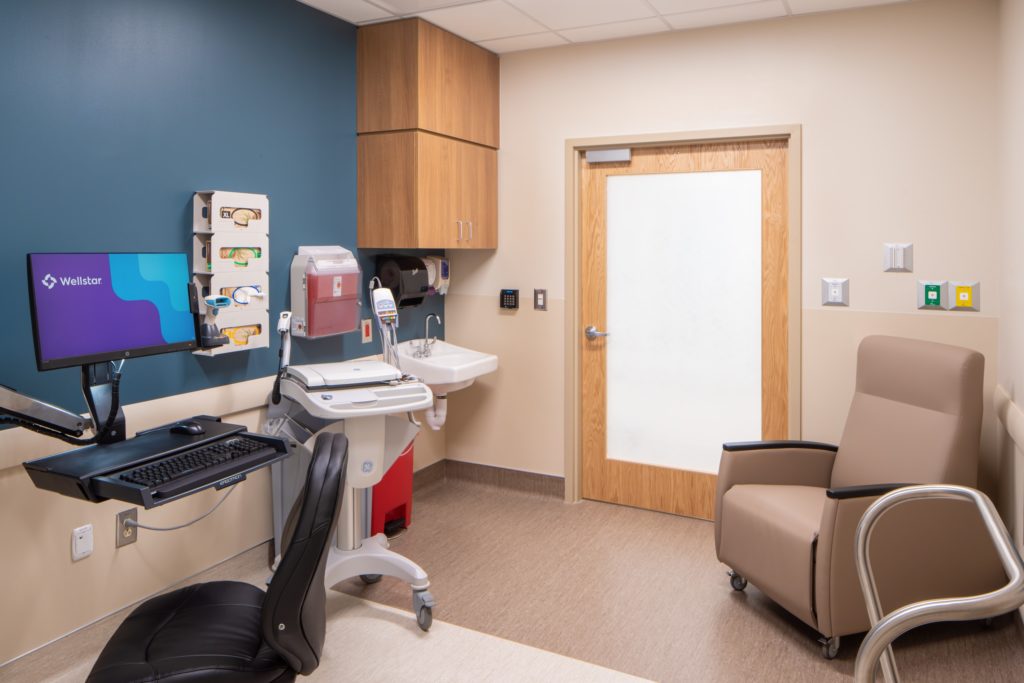New Emergency Department at Wellstar Kennestone Hospital opens at just the right time
By Haisten Willis
As the novel coronavirus continues to rock Cobb County, the nation, and the world, many scheduled events and projects have been subject to delays or cancellations. The opposite was true for the new emergency department at Wellstar Kennestone Hospital.
The massive, 263,000-square-foot facility couldn’t have opened at a better time. A July 20 ribbon-cutting was held for the new facility, which was in the works for nearly a decade, as a masked Georgia Gov. Brian Kemp and Georgia First Lady Marty Kemp were joined by Wellstar Board of Trustees Chair Otis Brumby III, Wellstar CEO Candice Saunders, and Wellstar Kennestone Hospital President Mary Chatman.
“This historic moment is the result of an inspiring team and strong community partnership centered on bringing world-class healthcare to every person, every time,” Saunders said during the ribbon-cutting. “The new emergency department is an asset to our system and all of the people we care for.”
The facility opened to the public three days later. Inside are 162,825 square feet of clinical space and 166 treatment beds. The Level II trauma center (defined as being able to initiate definitive care for all injured patients) is part of the state’s largest trauma network and, according to Wellstar officials, is expected to be one of the largest and busiest trauma centers in the entire nation.

“We’re a Level II trauma center and a certified comprehensive stroke and certified comprehensive cardiac center,” says Nancy Doolittle, executive director of nursing and emergency services at Wellstar Kennestone. “What those designations mean is that we’re able to care for the highest level of patients. If a stroke patient needs to have intervention done, we have neurosurgeons who have the ability to do that. If somebody needs to have open-heart surgery or other procedures beyond catheterization, it allows us to do that.”
The emergency department opened after two-and-a-half years of construction after officials broke ground on the new Kennestone expansion in February of 2018. But the project was in the planning phase for more than two years prior to the groundbreaking, and the idea for it dates back roughly 10 years.
In his statements at the ribbon-cutting, Kemp praised both the economic impact and the health impact of the facility. “The State of Georgia proudly supports Wellstar Health System and the more than 24,000 team members who are on the front lines providing outstanding and life-saving care to Georgians,” said Gov. Kemp, according to a press release. “The new emergency department at Wellstar Kennestone Hospital will have an immediate positive impact on our community by serving as a critical care resource to Georgians experiencing medical emergencies or trauma.”
The emergency department is larger than even the biggest Walmart Supercenter, and is one of the two largest and busiest emergency departments in the United States. It will be able to serve up to 600 patients per day, or 220,000 patients a year. Both figures are more than double that of the previous trauma and emergency capacities at Kennestone.
It’s still to be determined how the old emergency space will be used, but Doolittle said Wellstar leaders are looking at what best meets the needs of the community during the pandemic.
Wellstar officials stressed that the new center was designed and built with the community in mind as well. The healthcare system actively solicited feedback from community partners, using that input to design and build the new facility. “Wellstar Kennestone Hospital’s new emergency department was designed to continue to provide safe and high-quality care to our community,” said Chatman at the ribbon-cutting. “Wellstar actively solicited feedback from our community partners and used the input to build our new facility. Our new emergency department will be the industry leader in best practices, with world-class providers, team members, and service.”
When it comes to treating COVID-19, the new emergency department means the hospital has much more surge capacity if needed. Doolittle said hospital admissions through the emergency department have swelled and dipped throughout the pandemic. When social distancing was being heavily promoted in the spring they saw fewer patients, but the numbers started to go up later in the year.

“Some people may have been afraid of coming in, and were trying to keep their distance to be safe,” says Doolitte. “But by the time they made it to the hospital, they were sicker and should have come in sooner. I think that was difficult for everyone; we saw that across the country. Their needs didn’t go away, but many of them weren’t coming in.”
She emphasized that COVID patients are kept separately from others and that it’s always important to go to the emergency room if you have urgent medical needs. “You don’t want people staying home who should have come in,” she says. “We have the ability to segregate our lobby spaces. If for some reason there’s a wait, we can separate patients with symptoms of COVID. There are a lot of patient safety factors that we bring into our care.”
Aside from its impressive size, the emergency department also was designed with the aim of reducing wait times, expediting discharges, and enhancing the overall experience. There are separate entrances and wings for pediatric and adult patients, a streamline care initiation intake process, private exam rooms in place of curtain dividers, flexible spaces able to provide for treatment of both high- and low-acuity cases, and planned spaces and processes for de-escalation, isolation and decontamination for patients who present with infectious disease or behavioral health issues.
“There’s definitely a learning curve, but overall I am so proud of our team,” says Doolittle. “The day that we transitioned patients from the old to the new departments was seamless. It was a great transition. We learn new things every day, but overall it has been fantastic.”
The second floor of the department is dedicated to behavioral health, with 12 beds for specialized behavioral health and intervention services. There are three different ambulance bays for different levels of patient severity, and parking for up to 17 different ambulances at once.
The emergency department also includes 14 negative-pressure rooms (for airborne infectious disease management), direct access to the high acuity and trauma care area from a rooftop helipad via elevator, better vehicular access for both patients and emergency vehicles and an on-site, underground parking garage to drop off patients. Lastly, there are imaging rooms directly adjacent to trauma rooms, plus additional critical care equipment and technology.
“I’m so proud of the team at Wellstar and everyone who played a part in the design process,” says Doolittle. “We had a neighborhood committee that met frequently. To know that we had neighborhood insight and that they were part of the process was just amazing.”
The emergency department is the latest expansion for Wellstar Health System and for Kennestone Hospital, which is celebrating its 70th anniversary in 2020. Kennestone has more than 600 patient beds, serving hundreds of thousands of visitors a year and with one of only three Level II trauma centers in metro Atlanta.
Wellstar Health System now includes 11 hospitals, more than 300 medical office locations, nine cancer centers, 55 rehabilitation centers, three hospice facilities, one retirement home, 21 imaging centers, 15 urgent care locations, and five health parks.




